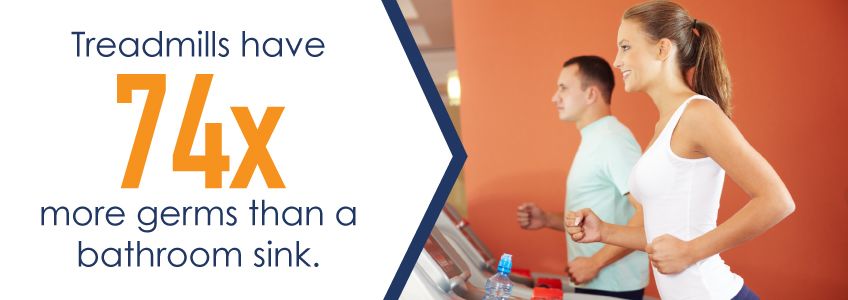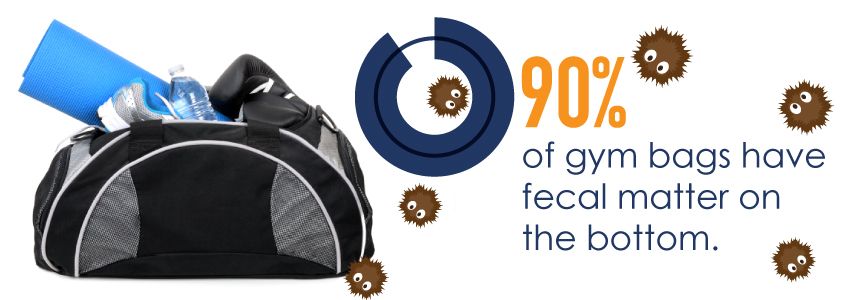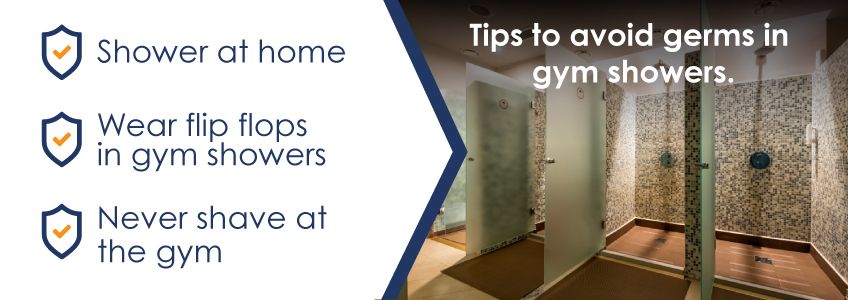How to Avoid Germs at the Gym
- Created: Monday, 23 May 2016 11:49
But have you ever actually stopped to think about what evil germs could be lurking around the gym you go to for your workout? Whether they are hiding in damp, dark places or out in the open, there is, in fact, an unhealthy side to fitness.
A FitRated.com study that involved swabbing 27 pieces of gym equipment at three different gyms uncovered some very worrying statistics — particularly if you're a regular gym-goer — regarding the cleanliness of gyms, and in particular fitness equipment. The study found:
- The average treadmill harbors 74 times more germs than a public bathroom sink.
- There are on average 39 times more bacteria on an exercise bike than on a cafeteria tray.
- Free weights contain around 362 times the amount of bacteria generally found in a public toilet.
- More than 70 percent of germs found in the gym are considered to be harmful to humans, and some of these are even antibiotic resistant.

There are 34,460 health clubs in the U.S. with a total of 54.1 million members using fitness equipment throughout the country, according to research by the International Health, Racquet and Sportsclub Association. Learning more about these germs, including what they are, where they are hiding, and how to avoid them, is certainly something we all need to be paying close attention to.
Types of Germs and the Types of Infections You Can Get
You go to the gym to keep fit and healthy. But in some cases you can actually get sick from working out. That's right, your gym can harbor germs.
Cold viruses can live on dumbbells. Flu-causing viruses can thrive on treadmills. Shower floors and steam rooms can harbor the fungus that causes athlete's foot. And pinkeye can be transmitted from a community exercise mat.
Men's Fitness magazine reported on some of the infections you can pick up in the gym. They include:
-
Klebsiella — This often antibiotic-resistant bacteria is generally found within the intestines and stools of healthy people. However, when it's found on gym equipment, in locker rooms or on water fountains, it can cause people to develop an infection.
Most often people affected by the bacteria find themselves with a UTI or even pneumonia. Dependent on how Klebsiella enters your body, you could even end up with meningitis.
-
Human Papillomavirus — You probably tend to think about HPV as a sexually transmitted infection, and you would be right. It's the most widely spread STI around, according to the Centers for Disease Control and Prevention.
However, it's still possible to become infected with HPV in other ways. When the virus comes into contact with the feet, say if you're walking barefoot in locker rooms or showers, it can cause plantar warts, which are often uncomfortable and difficult to treat.

-
E. Coli — You've probably heard the name E. coli before. Escherichia Coli, to give it its proper name, is commonly found within the stools and intestines of animals. Symptoms include vomiting and diarrhea.
Most commonly developing from ingesting contaminated food, E. coli can also be caught via dirty surfaces in the gym. People with immune system issues, as well as kids and the elderly, are most at risk of falling prey to the bug.
-
Flu — The virus, known as influenza, can be caught via droplets from the coughs and sneezes of an infected person or by touching a tainted surface, then putting your hands to your face. Just in case you're lucky enough to never have suffered from the flu, the symptoms to look out for are aches, coughing, chills, sore head, fever, malaise and occasionally vomiting and nausea. Unfortunately, it, too, can be contracted at the gym.
-
Staphylococcus Aureus — According to the American Public Health Association, MRSA, or Staphylococcus aureus bacteria, is the most serious type of germ found in the locker room. This bacterium can cause skin infections, boils and rashes, and is resistant to certain antibiotics.
Methicillin-resistant Staphylococcus aureus is an incredibly aggressive form of staph and can cause meningitis, sepsis and pneumonia, among other issues. MRSA infections can be severe or potentially life-threatening if the bacteria enters the body through abrasions, scrapes and cuts.
Thankfully, this form of the bacteria is incredibly rare. However, it should be noted that staph can be spread through sharing razors and towels. It can also be picked up via dirty gym equipment and direct skin-on-skin contact.
-
Candida — Probably most commonly known as the cause of yeast infections in women, this fungus can also give you ringworm and athlete's foot, as well as jock itch. It can be found in showers, locker rooms and anywhere that's warm and particularly wet. Trichophyton is also a germ that can cause athlete's foot, jock itch and ringworm.
There are varied symptoms of this yeast-like fungus depending on the body part that's been affected. Athlete's foot presents as peeling, flaky, itchy and cracked skin on the feet. You know you have jock itch when you get a particularly uncomfortable and rashy groin, while ringworm — as the name suggests — shows as ring-shaped rashes between fingers, on the palms of your hands, and also on toes. Thankfully, antifungal creams and on occasion antibiotics do the trick to get rid of candida.
-
Streptococcal Bacteria — You've no doubt heard of strep throat, which is caused by one of the 20 different variations of this nasty bacteria. In addition to this, the bacteria is incredibly contagious and spreads like wildfire via contact with infected surfaces, direct contact and also by droplets from coughs and sneezes.
The symptoms of strep infection can be as mild as a sore throat or as dangerous as a bad respiratory infection. Strep also causes serious infections, which can get deep into the layers of the skin.
Treatment is most commonly via antibiotics and antibiotic creams, although if the infection is particularly serious, a stay in the hospital and IV drugs are commonplace. Streptococcal bacteria is spread through contact, either directly with an infected person or with a surface that has been contaminated with it, such as sweat-laden gym equipment.
To put it simply, gyms are the breeding ground of germs in different shapes and sizes, just like the people who work out in them.
Where Do Germs Hide at the Gym?
So now you've got an idea of the types of germs that lurk in the gym, but where in the gym do they like to take up residence? Turns out, germs in the gym don't discriminate — they'll live just about anywhere and everywhere.
To ensure you don't leave the gym with anything other than hard abs, learn where these nasty microorganisms hang out. Here's a hint — they have a lot of hiding places.
Weights, Weight Machines and Exercise Balls
Problem: These are loaded with germs due to the number of people who use them.
Solution: Always remember to carry your own antibacterial hand gel to use before and immediately after your workout. Get into the habit of wiping gym equipment down with disinfectant prior to and after each and every use.
Exercise Mats
Problem: A haven for horrible microbes that can give you colds, flu and even Hepatitis A, shared mats are a real no-no.
Solution: Instead, invest in your own and clean it with a bleach-doused wipe after each use.
Locker Room
Problem: Locker rooms are the perfect hot and sweaty environment for germs to breed. With fecal matter transferred from outdoor shoes to nasty yeast infection germs found on benches, it's just not worth taking the risk.
Solution: To ensure you stay as safe as possible, don't ever sit around naked on benches, and always protect your feet with flip flops.
Gym Towels
Problem: This might make you feel a little ill, but it's the truth. That towel from the gym pile you think is clean may not be. Why? Some gyms transport dirty towels in the exact same hamper as supposedly clean ones.
Solution: It's not worth risking catching E. coli or worse by using the gym's own towels. Instead, bring your own towel. In addition, mark one side and only let that part come into contact with gym equipment. Use the other side for wiping yourself down after a sweaty workout. Remember to get into the habit of bringing an extra towel if you tend to shower at the gym, and when you return home make cleaning gym towels your top priority.
Gym Bag
Problem: Thankfully, the majority of germ lurkers within your gym bag will be yours. But that doesn't mean they're entirely safe. Think about it. You set your bag down all over the gym. How could it not pick up one germ, let alone hundreds, considering 90 percent of gym bags have fecal matter on the bottom.

Solution: If you want to minimize this risk, you should carry only vinyl or plastic bags, which can be wiped down easily. In addition to this, regularly clean inside your bag with disinfectant wipes and wash the entire thing once a week.
Cardio Machines
Problem: They're teeming with other people's sweat, viruses and fungus.
Solution: Always wipe down any machine you use with disinfectant before and after each use. Always.
Pool
Problem: Let's face it, we all know some people like to pee in the pool. As well as that, there's fecal matter to think about. You don't want to contract a bad eye or ear infection by simply going for a swim.
Solution: To combat the risk of getting ill, check out your gym's data on pool cleanliness and pH. Also bear in mind that chlorine reacts with microorganisms, so if a pool smells particularly overly chlorinated, it might still be dirty. In addition to all this, wear a swim cap, ear plugs and goggles every time you go for a swim. You might feel like a nerd, but you'll be far less likely to catch an illness.
Water Bottles
Problem: Germs can pass from you to your bottle and can then lurk around in your drink.
Solution: Always use a bottle with a wide top, wash it out every day, and ensure you keep your water refrigerated before you leave home. Germs just love warm and moist places.
Showers
Problem: These are understandably a complete haven for infections, such as warts and athlete's foot.
Solution: In order to avoid these, just get showered the second you get home. If this isn't an option, use antimicrobial soap while showering at the gym, and dry your feet carefully. Also, never shave at the gym. Germs can enter your body so much more easily through cuts and nicks. Wear flip flops when you shower, too.
Other Top Tips to Avoid Germs at the Gym

Besides all of the above solutions to keep your gym experience germ free, practice the following tips before, during and after your workouts:
Before Your Workout
- Inspect a gym for cleanliness, ventilation and proper staffing before joining.
- Ensure you speak with the management with regard to cleaning agents used in the gym. These should be approved by the Environmental Protection Agency.
- Ask about the gym cleaning routine, and don't worry that you're being annoying.
- Consider buying an antimicrobial gym bag.
During Your Workout
- Remember to wash your hands often.
- Carry antibacterial hand gel — and use it often.
- Always place a gym towel on equipment before you sit on it.
- Bring your own towels with you and never share them.
- Always wipe down the machines and equipment before and after use.
- Don't lay on community mats. Bring your own yoga or Pilates mat.
- Keep your distance in spin and aerobics classes to reduce your contraction of airborne pathogens.
- Ensure all cuts and scrapes are protected with a Band-Aid.
- Never, ever go barefoot anywhere in the gym.
- Never shave at the gym.
- Always place a gym towel on a sauna bench before sitting.
- Don't touch your face while in the gym.
- Don't drink out of the gym's water faucet, or at the very least don't touch the spout.
After Your Workout
- Try to shower at home rather than at the gym.
- Put used workout clothes away in your gym bag separately.
- Wash workout gear and damp towels in hot water.
- Remember to disinfect your gym bag on a regular basis.
While exercising at the gym is one of the healthiest pastimes around, it's imperative you follow good hygiene rules each and every time you work out. When you exercise, exercise caution. Your trim, toned, and germ-free body will thank you for it.
Browse the Finest Selection of Gym Towels
At Towel Super Center, we have a broad array of gym towels, including face towels, washcloths and hand towels in a variety of colors. They're perfect for wiping down your face, hands or gym equipment. Because gym towels take a beating and need to be laundered repeatedly, it's best to invest in heavy-duty construction. Our gym towels are soft, quick drying and don't hold onto unpleasant odors. Check them out today.





